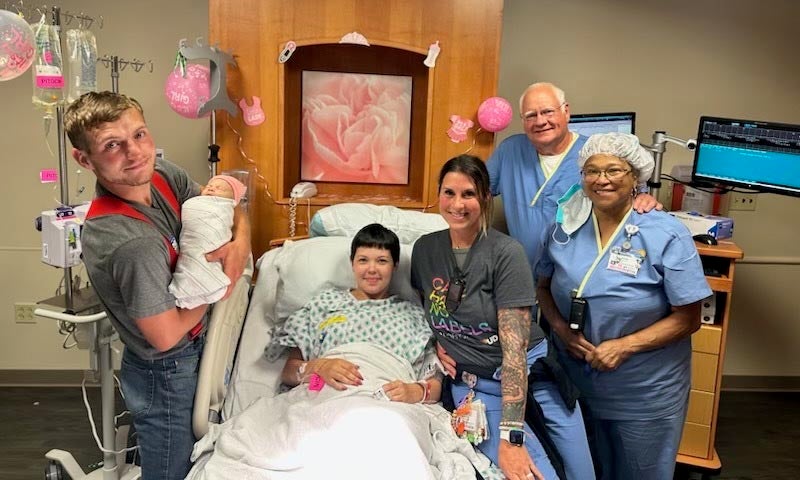Blood
Fetal transfusions that saved unborn baby Phoebe’s life
Every three weeks, Katrina Crume and Aaron Dean Calloway made the nearly two-hour journey from their home near Owensboro, Kentucky, to Louisville so their baby, Phoebe, could receive a lifesaving blood transfusion. What made these transfusions remarkable was Phoebe was still in the womb.
What made them necessary was incompatibility between Katrina’s and Phoebe’s blood.
Phoebe is Rh positive, while Katrina is Rh negative. Known as Rh incompatibility, the condition meant that antibodies in Katrina’s body were attacking her baby’s blood. The incompatibility doesn’t affect the pregnant person, but can cause anemia in the fetus as red blood cells die faster than new ones are created. Jaundice is also a common result.
In the most severe cases, Rh incompatibility can cause liver failure, heart failure and death of the baby.
The condition isn’t common, and the need for fetal transfusions is even rarer. In mild cases no fetal transfusion is necessary, and most recover from a mild case.
In Phoebe’s case, the Norton Children’s Maternal-Fetal Medicine and Norton Hospital labor and delivery teams went into action to save the unborn baby.
“Using an ultrasound to guide us, we insert a needle into the baby’s umbilical cord,” said Kristin E. Reeve, M.D., a specialist with Norton Children’s Maternal-Fetal Medicine. “We can then transfuse the necessary blood product directly to the baby to reverse the anemia.”
Norton Children’s Maternal-Fetal Medicine, a part of Norton Women’s Care
If you’ve found out you have a complicated pregnancy, ask your obstetrician about a referral to our maternal-fetal medicine specialists
Call (866) 574-4111 for information
When the transfusions began, Phoebe was around the size of a hand and the umbilical cord the diameter of a pencil. The needle is inserted into a tiny vein in the umbilical cord.
“The goal is to get the baby to the point where he or she can safely be delivered,” said W. Vance Cuthrell, M.D., also a specialist with Norton Children’s Maternal-Fetal Medicine. “In this case, our work was able to safety bring Phoebe to nearly full term.”
The delicate and complicated transfusion procedure carries several risks, but Katrina described being in good hands with her care team.
“I had to do this during a previous pregnancy so I knew it was a possibility,” Katrina said. “But it was still tough and a bit scary. Dr. Cuthrell, Dr. Reeve and everyone at Norton Hospital made it as easy as possible, and they became like family.”
Fetal transfusions require a large team: maternal-fetal medicine specialists, nurses and technologists — plus ultrasound, laboratory and blood bank staff — and even security. The blood bank staff prepared the blood the baby needed. After the team targeted the location of the baby’s umbilical cord, a blood sample was collected.
With help from the security team, the sample was literally run down four flights of stairs to the laboratory. A rapid test on the sample determined how much blood the baby needed. After the blood slowly was given to the baby through the umbilical cord, another sample was rushed to the laboratory to ensure the baby had received enough.
A team from the Norton Children’s Hospital neonatal intensive care unit also was on standby for a possible emergency delivery.
“These procedures do have risk to them,” Dr. Reeve said. “These include infection, bleeding of the baby, blood clots and even the need to perform an emergency cesarean section.”
With careful planning and expertise, these were avoided.
“We had times during Katrina’s pregnancy that the entire team had to be called in to do an emergency transfusion,” Dr. Cuthrell said. “Each person’s role was incredibly important to the success of the procedure, and everyone was willing to commit to helping.”
The specialists with Norton Children’s Maternal-Fetal Medicine, part of Norton Women’s Care, have training and expertise to care for moms and babies during high-risk pregnancies, such as the condition that required transfusions to treat baby Phoebe in the womb.
“We are so happy that Phoebe is here and happy and healthy,” Katrina said. “We’re so grateful to everyone for working to save our baby.”
Rh incompatibility and Rh disease
In blood typing, positive or negative denotes the presence or absence of a protein known as Rh factor.
When a person with Rh-negative blood becomes pregnant with an Rh-positive fetus, there is Rh incompatibility. While mother and baby don’t share blood, the blood can mix for various reasons during pregnancy or labor.
If the two blood types come into contact, the pregnant person’s body reacts to the Rh-positive blood as foreign and creates antibodies in an immune response to fight it. Often, an injection of immune globulin is enough to prevent the reaction.
It’s unlikely for fetal blood to mix with the pregnant person in a first pregnancy until delivery. Future pregnancies, however, raise a risk that the pregnant person’s Rh-negative blood will come into contact with an Rh-positive fetus, triggering an immune reaction — Rh disease — that could be severe.

